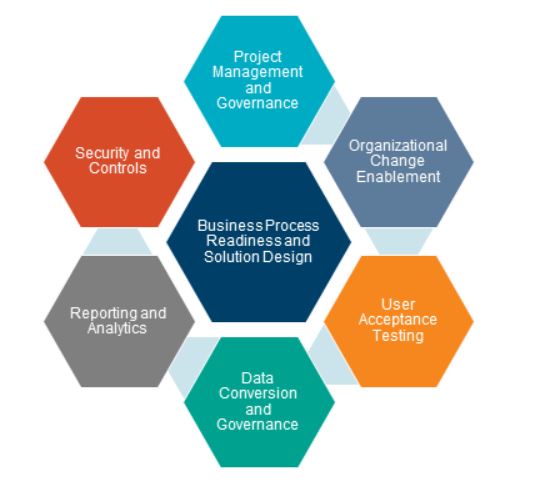Understanding the complex responsibilities each area of an organization has in an SAP S/4HANA or Central Finance transformation is essential to the effort’s success. In this two-part series, we look at how each of these seven key factors might impact the initiative. Readers might also be interested in this recent blog: Key Ingredients for a Successful SAP Finance Transformation.
Any large business transformation or technology migration project brings inherent challenges that make the need for clarity a must. A poorly executed project can create risks such as negative impacts to financial performance, damage to brand, loss of customers and goodwill, and loss of talent. Most system integrators are technical experts that focus on customizing the system according to the requirements provided to them. This only represents one piece of the puzzle that constitutes a successful implementation. Even when the project is supported by a strong system integrator, it is critical for the business to assume responsibilities for key activities before, during and after the implementation. For an SAP S/4HANA (S/4HANA) or Central Finance (CFIN) implementation project, the business is typically responsible for seven key areas presented below. Let’s take a closer look at each.

Business Process Readiness and Solution Design
In general, the trend is to strive for a stable core S/4HANA or CFIN solution and adopt standard functionality wherever possible. With that said, every company has processes that provide competitive advantage, or other significant business value that are not met by standard functionality. These processes should truly be differentiating to keep enhancements and customization in SAP to a minimum. To meet operational expectations for the new system, the business should design process models for the future end-to-end state of each of these differentiating business processes. This overarching business process vision (both standard and differentiating) is called the “solution design.” Typically, the system integrator will focus on system blueprinting or a fit/gap assessment to standard functionality rather than designing future processes; therefore, the business must be responsible for defining the vision and operational expectations of the new system. In addition, the business must ensure that the technical solution the system integrator proposes will satisfy the business process vision and future-state goals. Ideally, the business should design the process models for these key processes prior to project kick-off – this is what we refer to as business process readiness.
As an example, the process model should represent the conceptual design of the business process and should identify areas such as: manual activities, activities that require human interaction, who will execute the manual activities and automated activities performed by the system. Documentation should include any business rules (e.g., customer price calculation, cost allocation, tax computation) governing the above activities.
The solution design should also serve to guide testing plans, and applicable documentation can be leveraged for training purposes. The business preparing the solution design up front helps ensure:
- The system integrator is building the system according to management’s vision
- The system is properly validated and will support the company as envisioned
- Users will be familiar with the solution and ready to use it effectively upon go-live.
Project Management and Governance
Strong project management and governance is the foundation to any S/4HANA or CFIN implementation. Companies should institute a comprehensive governance structure for the entire program as major system implementations are complex and cross-functional. Program governance is a framework by which responsibilities are assigned, risks identified, decisions made and issues resolved throughout a program’s lifecycle. Each governance group and individual leadership role in the framework should have a clearly defined set of responsibilities and authorities to enforce accountability.
Most system integrators will provide project management capabilities to oversee their team’s activities, but many will stop short of providing the level of management needed to oversee the end-to-end implementation. Common gaps include oversight of internal business and IT resources, management of other vendors and open communication with company leadership and stakeholders on risks, issues and decisions.
Key tasks for the business to focus on for program management and governance include the following:
- Establish a project management office (PMO) structure, roles and responsibilities
- Define the overall program governance
- Validate the completeness of the program plan
- Expand the governance structure to enable a clear path for real-time decision making
- Establish a continual monitoring and communication of program risks
- Define a “single source of truth” for program status communication.
Organizational Change Enablement
As the solution design is established, the organizational impact of system and process changes must be determined, evaluated and planned to ensure the anticipated benefits are realized. A clear understanding of the organizational impact will help to shape the training strategy and plans and help ensure that the affected end-users understand process changes, new policies and procedures and how to execute their function in the new system.
Early in the implementation planning stages, the business should review the system integrator’s plans for supporting the user community. This should include activities planned during the implementation (e.g., communications and training) and activities after go-live, such as go-live support. Ultimately, the goal is to develop a change enablement plan that will raise awareness with key stakeholders, obtain their buy-in, and ensure their commitment to support the changes and the performance improvement objectives of the initiative.
To develop a comprehensive change enablement plan, the business should consider the following:
- Analyze the impact on stakeholders early in the project life cycle
- Develop strategies to address barriers to change and ensure effective adoption
- Address how critical process changes will be adopted by the organization
- Define KPIs/metrics for measuring adoption
- Build a communication and training approach.
Data Conversion and Governance
For any organization undergoing an S/4HANA or CFIN transformation, data cleansing and governance is a crucial activity that requires a well thought out plan. The lack of data quality and governance can delay go-live, disrupt business operations, and severely impact user adoption. Companies should start early (often prior to project kick-off) on the data workstream to help ensure the timeline is not impacted from lack of data quality.
The data conversion aspect of an implementation is essential to many other aspects of the implementation such as having a comprehensive system design and efficiently testing the new system. High data quality helps the business to achieve confidence that the system will function in the production environment as designed. Keep in mind, data governance expands beyond a successful rollout of the new system and includes ongoing monitoring, management and effective control of business-critical data.
Some common gaps around data conversion include early identification of data sources and data quality are not done effectively leading to underestimating the level of effort to get the data prepared and converted, inadequate processes and tools for data extraction, cleansing and preparation and inadequate planning of the workstream often causes resource constraints late in the project and shortcutting the quality of conversion.
To avoid complications with data conversion, the business should consider:
- Clearly defining the scope and strategy for data conversion and obtain sign-off from business owners and IT
- Assessing the quality of the source data early in the project plan and outlining roles and responsibilities for cleansing and validating the source data (If data quality issues are identified later in the project lifecycle, the implementation will likely be delayed)
- Performing multiple mock conversions with validation to ensure a smooth migration, cutover and go-live
- Thoroughly assessing the timeline and resources to convert and validate the data and identify the appropriate tools to automate the conversion process.
In Part 2, we will continue the conversation around understanding business responsibilities during an SAP S/4HANA or Central Finance transformation journey, covering user acceptance testing, reporting and analytics, and security and controls.
To learn more about our SAP capabilities, contact us or visit Protiviti’s SAP consulting services.






